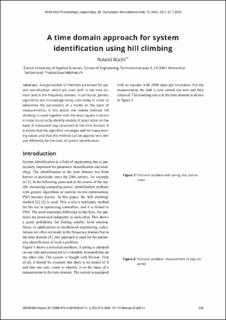Please use this identifier to cite or link to this item:
https://doi.org/10.21256/zhaw-25494Full metadata record
| DC Field | Value | Language |
|---|---|---|
| dc.contributor.author | Büchi, Roland | - |
| dc.date.accessioned | 2022-08-25T08:12:51Z | - |
| dc.date.available | 2022-08-25T08:12:51Z | - |
| dc.date.issued | 2022 | - |
| dc.identifier.isbn | 978-3-901608-97-1 | de_CH |
| dc.identifier.uri | https://digitalcollection.zhaw.ch/handle/11475/25494 | - |
| dc.description.abstract | A large number of methods are known for system identification, which are used both in the time domain and in the frequency domain. In particular, genetic algorithms are increasingly being used today in order to determine the parameters of a model on the basis of measurements. In this article, the related method 'hill climbing' is used together with the least square criterion in order to correctly identify models of small order on the basis of measured step responses in the time domain. It is shown that the algorithm converges well for many starting values and that this method can be applied very well and efficiently for the topic of system identification. | de_CH |
| dc.language.iso | en | de_CH |
| dc.publisher | ASIM - Arbeitsgemeinschaft Simulation | de_CH |
| dc.relation.ispartofseries | ARGESIM Report | de_CH |
| dc.rights | Licence according to publishing contract | de_CH |
| dc.subject | Control theory | de_CH |
| dc.subject | Machine learning | de_CH |
| dc.subject.ddc | 003: Systeme | de_CH |
| dc.title | A time domain approach for system identification using hill climbing | de_CH |
| dc.type | Konferenz: Paper | de_CH |
| dcterms.type | Text | de_CH |
| zhaw.departement | School of Engineering | de_CH |
| dc.identifier.doi | 10.11128/arep.20.a2014 | de_CH |
| dc.identifier.doi | 10.21256/zhaw-25494 | - |
| zhaw.conference.details | 26. Symposium Simulationstechnik (ASIM 2022), Wien, Österreich, 25.-27. Juli 2022 | de_CH |
| zhaw.funding.eu | No | de_CH |
| zhaw.originated.zhaw | Yes | de_CH |
| zhaw.pages.end | 210 | de_CH |
| zhaw.pages.start | 205 | de_CH |
| zhaw.parentwork.editor | Breitenecker, Felix | - |
| zhaw.parentwork.editor | Deatcu, Christina | - |
| zhaw.parentwork.editor | Durak, Umut | - |
| zhaw.parentwork.editor | Körner, Andreas | - |
| zhaw.parentwork.editor | Pawletta, Thorsten | - |
| zhaw.publication.status | publishedVersion | de_CH |
| zhaw.series.number | 20 | de_CH |
| zhaw.publication.review | Peer review (Publikation) | de_CH |
| zhaw.title.proceedings | Proceedings Langbeiträge ASIM SST 2022 | de_CH |
| zhaw.author.additional | No | de_CH |
| zhaw.display.portrait | Yes | de_CH |
| Appears in collections: | Publikationen School of Engineering | |
Files in This Item:
| File | Description | Size | Format | |
|---|---|---|---|---|
| 2022_Buechi_Time-domain-approach-system-identification-hill-climbing.pdf | 322.03 kB | Adobe PDF |  View/Open |
Show simple item record
Büchi, R. (2022). A time domain approach for system identification using hill climbing [Conference paper]. In F. Breitenecker, C. Deatcu, U. Durak, A. Körner, & T. Pawletta (Eds.), Proceedings Langbeiträge ASIM SST 2022 (pp. 205–210). ASIM - Arbeitsgemeinschaft Simulation. https://doi.org/10.11128/arep.20.a2014
Büchi, R. (2022) ‘A time domain approach for system identification using hill climbing’, in F. Breitenecker et al. (eds) Proceedings Langbeiträge ASIM SST 2022. ASIM - Arbeitsgemeinschaft Simulation, pp. 205–210. Available at: https://doi.org/10.11128/arep.20.a2014.
R. Büchi, “A time domain approach for system identification using hill climbing,” in Proceedings Langbeiträge ASIM SST 2022, 2022, pp. 205–210. doi: 10.11128/arep.20.a2014.
BÜCHI, Roland, 2022. A time domain approach for system identification using hill climbing. In: Felix BREITENECKER, Christina DEATCU, Umut DURAK, Andreas KÖRNER und Thorsten PAWLETTA (Hrsg.), Proceedings Langbeiträge ASIM SST 2022. Conference paper. ASIM - Arbeitsgemeinschaft Simulation. 2022. S. 205–210. ISBN 978-3-901608-97-1
Büchi, Roland. 2022. “A Time Domain Approach for System Identification Using Hill Climbing.” Conference paper. In Proceedings Langbeiträge ASIM SST 2022, edited by Felix Breitenecker, Christina Deatcu, Umut Durak, Andreas Körner, and Thorsten Pawletta, 205–10. ASIM - Arbeitsgemeinschaft Simulation. https://doi.org/10.11128/arep.20.a2014.
Büchi, Roland. “A Time Domain Approach for System Identification Using Hill Climbing.” Proceedings Langbeiträge ASIM SST 2022, edited by Felix Breitenecker et al., ASIM - Arbeitsgemeinschaft Simulation, 2022, pp. 205–10, https://doi.org/10.11128/arep.20.a2014.
Items in DSpace are protected by copyright, with all rights reserved, unless otherwise indicated.